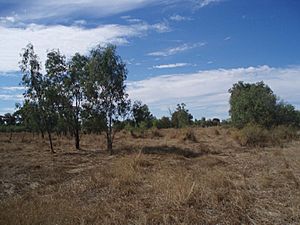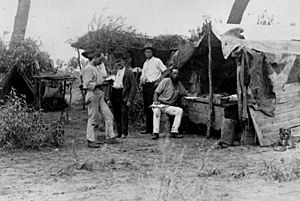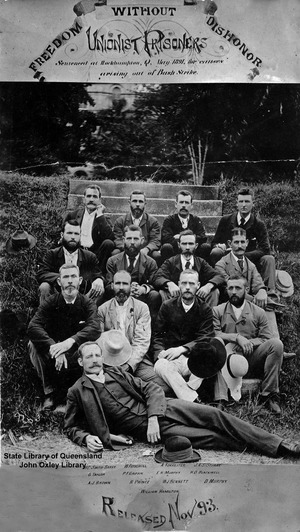Shearers' Strike Camp Site, Barcaldine facts for kids
Quick facts for kids Shearers' Strike Camp Site, Barcaldine |
|
|---|---|

Site of the Shearers' Strike Camp, 2009
|
|
| Location | Bank of Lagoon Creek, Barcaldine, Barcaldine Region, Queensland, Australia |
| Design period | 1870s - 1890s (late 19th century) |
| Built | 1891 |
| Official name: Shearers' Strike Camp Site, Barcaldine | |
| Type | state heritage (archaeological) |
| Designated | 21 October 1992 |
| Reference no. | 600019 |
| Significant period | 1891 (historical) |
| Significant components | oven - antbed, blazed tree/dig tree/marker tree |
| Builders | Shearers on strike |
| Lua error in Module:Location_map at line 420: attempt to index field 'wikibase' (a nil value). | |
The Shearers' Strike Camp Site is a special historical place. It is located on the bank of Lagoon Creek, near Barcaldine, in Queensland, Australia. This site was built in 1891 by shearers who were on strike. It is now a protected heritage site, added to the Queensland Heritage Register on 21 October 1992.
Contents
The Great Shearers' Strike of 1891
The Shearers' Strike camp site was a very important place during the 1891 strike. This strike was a big disagreement between farm owners and their workers. Even though the strike did not fully succeed, it had a huge impact on Australian politics. It led to the first worker representative being elected to the Queensland Parliament. It also helped create the Australian Labor Party.
Why Workers Went on Strike
Barcaldine became a town in 1886 when the railway line from Rockhampton ended there. Before this, the area was already home to large sheep farms. These farms were like small towns themselves. They had places for workers to live, shops, and workshops. The farm owners had a lot of power over their workers. These workers were often seasonal, meaning they only worked during the shearing season.
Workers faced tough conditions and low pay. There was also a worry that cheaper workers from other places might take their jobs. These problems made many workers unhappy.
Unions Form to Help Workers
Barcaldine was a good place for unions to start. Many seasonal workers came through the town because it was the end of the railway line. It was hard to find work, and many faced money problems. This helped workers feel a sense of togetherness and support.
In 1887, the Central Queensland Carriers Union was formed in Barcaldine. The Queensland Shearers' Union started in Blackall. Within a year, the Shearers' Union had 1300 members. This showed that workers felt they needed to work together to get fair pay and conditions. In 1888, the Central Queensland Labourers' Union was also formed in Barcaldine. These three unions were key to the 1891 strike.
In Brisbane, the Trades and Labour Council was formed in 1885. It later became the Australian Labour Federation in 1889. In Barcaldine, farm owners formed their own group, the Pastoral Employers' Association, in the same year. This group decided to lower workers' pay. Many workers then joined unions. Bad weather in 1890 delayed a big fight.
By January 1891, union leaders met in Barcaldine. Farm owners tried to make shearers sign "freedom of contract" forms. These forms would make workers agree to terms that ignored union rules. So, the unions called a strike. Employers started bringing in workers who were not part of the unions from other areas. In February, strikers, some carrying weapons, gathered at Barcaldine.
Life at the Strike Camp
During the strike, camps were set up in many places. But the main focus was on Barcaldine. The biggest camp was on the southern bank of Lagoon Creek. It is said that up to 1000 strikers lived there. Some even had their families with them.
The camp was very well organised. Tents were set up in neat rows with clear paths between them. Strikers received food, soap, tobacco, and salt. They even built an oven out of ant bed (a type of soil) to bake fresh bread. There were also activities for fun. A library tent was set up, and games like cricket were played.
Strikers felt very strongly about their cause. They marked a tree on the north-eastern edge of the camp. They painted words on it that said, "United we stand. Divided we fall. A.L.F. the strike camp 1891 W. Vincent, E Car...".
The Strike Ends and Its Impact
The Queensland Government sent police and soldiers to deal with the strike. The strikers practised marching and held torchlight parades in the town. Many people in Barcaldine supported the strikers. In March 1891, the situation got more serious. Carriers and railway workers joined the strike to show support. More soldiers arrived. Barcaldine became the centre of attention for the whole country. People expected a fight.
Towards the end of March, an old law was used to arrest all members of the strike committee. They were charged with "conspiracy" (planning something illegal). With their leaders gone, and with heavy rain and sickness in the camp, the strikers began to leave. Shearing season had also started with non-union workers brought in by soldiers.
On June 15, the strike was officially called off. Most of the strike leaders received long prison sentences. Even though the strike failed at the time, it had huge effects. The next year, Thomas Joseph (Tommy) Ryan became the first worker-backed politician elected to the Queensland Parliament. Because the strike brought workers together, it was a key event in the creation of the Australian Labor Party.
Remembering the Strike
The strike is a very important part of Barcaldine's history. In 1982, townspeople re-enacted the strike. In 1987, a group was formed to remember the strike. They put up a monument near the famous Tree of Knowledge. This tree was where workers met at the Barcaldine railway station.
In 1988, an expert named Brian Egloff studied the area to find the exact location of the camp site. In 1991, more detailed studies and digging were done. They found old items from the strike, like metal containers, bottles, ammunition, and horse and shearing tools. The most visible thing left from the strike is the remains of the ant bed camp oven.
The 100-year anniversary of the strike in 1991 was a big event. Many Labor politicians from around Australia came. The Workers' Heritage Centre was also opened then.
What the Camp Site Looks Like Today
The camp site is about 3 kilometres (1.9 mi) north-east of Barcaldine. It is on the south side of Lagoon Creek. The area has some trees, mostly gidgee trees. Today, the only clear signs of the 1891 strike are the remains of the ant bed camp oven. There is also a blazed tree and a few scattered old items. Some of these items are from after the strike.
The strikers were not the first people to camp here. Evidence shows that Aboriginal people used the site before. Later, drovers (people who move livestock) also used it for camping.
The blazed tree is a coolabah tree. It is on the north-eastern edge of the camp site. The main part of the tree is dead, but a new branch has grown from its base. This branch was growing well when checked in 2000. A tree expert looked after it in 1993. The mark cut into the base of the tree in 1891 has grown over a bit, but you can still see it clearly. However, the words that were painted on it can no longer be seen.
Why This Site is Important
The Shearers' Strike Camp Site in Barcaldine was added to the Queensland Heritage Register on 21 October 1992. This means it is a very important historical place.
Showing Queensland's History
This camp site was the main spot for the 1891 Shearers' Strike. This strike was a major event in Queensland's history. It was a turning point in how workers organised themselves in Australia. It also played a big part in forming the Australian Labor Party.
Learning from the Past
The Strike Camp Site can help us learn more about what life was like for shearers in the late 1800s. By studying items found here, we can understand their daily lives and culture.
Special Meaning for the Community
The Strike Camp Site is very important to the people of Barcaldine. It is a big part of their local identity. Many people in the town are descendants of those who took part in the strike.
Connected to Important Groups and People
The Shearers' Strike Camp Site has a special link to the history of the Australian Labor Party and trade unions in Queensland. It is also connected to important people like William Hamilton and George Taylor. These men were strike leaders who were jailed but later became important Labor politicians. It is also linked to many other people who were part of this historic event.




